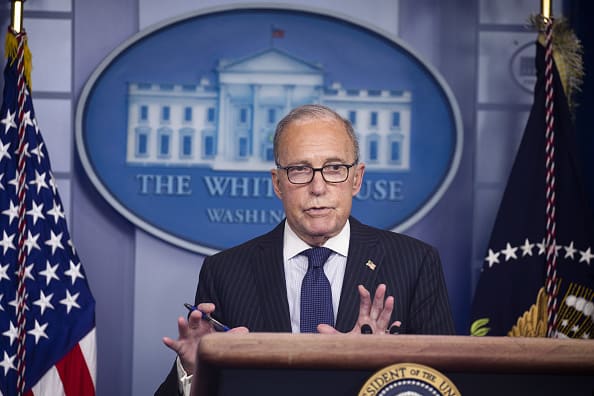Trump’s $300 unemployment benefit may take more than a month to arrive — if it comes at all

Larry Kudlow, director of the U.S. National Economic Council, speaks during a press briefing at the White House on July 2.
Michael Reynolds/EPA/Bloomberg via Getty Images
Won’t be ‘quick’
The exact timing of the new benefit is impossible to nail down, given some confusion around aspects of Trump’s order. States will also likely vary in their approaches and may have challenges building out their systems to accommodate the benefit. Some may decide not to offer it at all.
But the situation is fluid and amounts to a long lag time, experts said.
“It’s not something that’s going to be quick,” said Eliza Forsythe, a labor economist and assistant professor at University of Illinois at Urbana-Champaign.
“I don’t think anybody knows how long it will take, but it’s certainly not something any unemployed person can count on within a few weeks,” she added.
Meanwhile, more than 30 million Americans are collecting unemployment benefits, according to the Labor Department. More than 1 million people apply for aid each week, the 20th straight week claims have exceeded that figure, a level that hadn’t previously been touched since record-keeping began in the 1960s.
A loan program supporting jobs at small businesses ended on Saturday, meaning more layoffs could be coming. In addition, millions of renters and homeowners around the country recently lost state and federal eviction protections.
The loss of the $600-a-week unemployment subsidy, enacted by the CARES Act, leaves some with as little as just $5 or $10 a week in jobless benefits from the state.
Trump’s order was billed as an offer of an extra $400 a week. It amounts to a $300 federal supplement plus $100 from the state, but states won’t necessarily have to kick in any additional funding based on the program guidelines.
Reasons for a delay
There are several reasons the aid could be delayed.
For one, adding an extra $300 a week to an unemployment check is more complicated than simply plugging a few numbers into a state computer system, said Michele Evermore, a senior policy analyst at the National Employment Law Project.
The executive order stipulates that state unemployment agencies will administer the extra aid, but the program delivering the aid is technically a “lost wages assistance” program that’s separate from states’ unemployment systems.
This means states will have to build out a new, parallel system to pay benefits. And, since the funding comes from a federal disaster-relief fund overseen by the Federal Emergency Management Agency, states must figure out how to route the aid from a source other than their typical unemployment trust funds.
“This is actually not something states have ever had to do before,” said Evermore, an unemployment expert.
Trump also placed caveats on the receipt of the $300 federal boost, which may complicate states’ efforts.
For example, people currently getting less than $100 a week in state benefits won’t be eligible for the federal subsidy. States will have to code in that rule to ensure compliance.
Even the prior $600-a-week enhancement — which was available to all recipients of unemployment benefits and less complex to administer — took more than a month from the passage of the CARES Act for all states to start paying it.
“This isn’t at all like adding in the extra $600 was,” Evermore said.
New York Gov. Andrew Cuomo, the chair of the National Governors Association, and Arkansas Gov. Asa Hutchinson, the Association’s vice chair, expressed concern “about the significant administrative burdens and costs this latest action would place on the states,” according to a statement issued Monday.
They called for Congress and the White House to broker a legislative deal instead to come up with a “workable solution.”
Trump’s executive order comes after negotiations between top Democrats and White House officials stalled. House Democrats passed legislation in May to extend the $600 subsidy until early next year. Senate Republicans countered with a $200-a-week proposal in late July, the same week the original aid was expiring. It’s unclear when or if those talks will resume.
Kudlow, director of the National Economic Council, believes implementation “is not that hard” for states.
“We will work with them if there are any complications,” he said. “They’ve already changed their programs to meet the CARES generosity from last March, so they’re already on their way.”
The aid would also be retroactive to the week ended Aug. 1 — the same week the $600 benefit expired.
Reluctance among states
But it’s not a given that states will make the $300 benefit available. State officials have to request the assistance from the federal government.
Governors in states like California, Delaware, Florida, Kentucky, Mississippi, New Jersey and New York have signaled apprehension toward the new benefit — whether for cost, administrative or legal reasons — in recent days.
While their opinion may change and the White House could modify its rules, the reluctance demonstrates that unemployed Americans aren’t necessarily guaranteed to receive federal jobless aid.
The $300 benefit would only be available until Dec. 6, or until the $44 billion in federal funding allocated to the program runs out — whichever occurs first.
The Committee for a Responsible Federal Budget estimates that the $44 billion would last about five weeks.
States may ultimately decide it’s not worth the cost and effort to administer for only a few weeks’ worth of money, Forsythe said.




